Excerpts from Jim Conrad's
Naturalist Newsletter
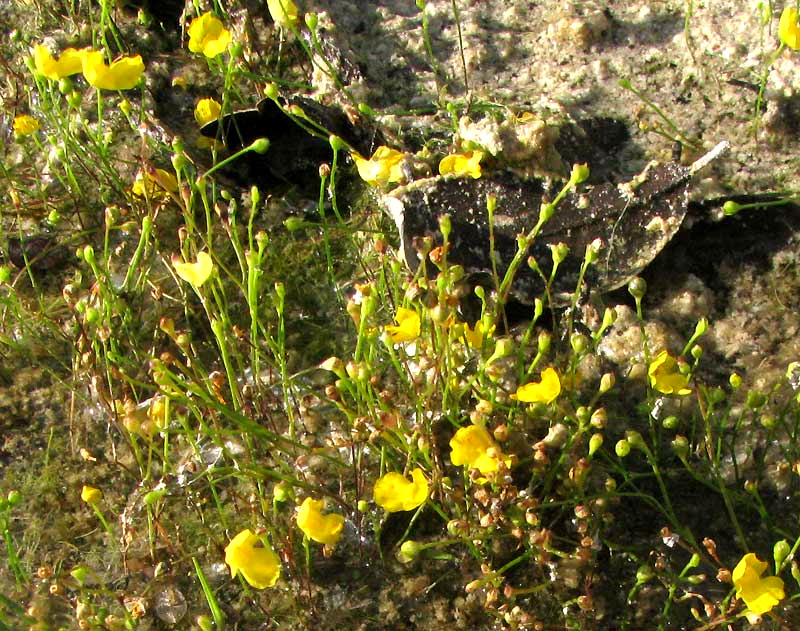
from the July 14, 2013 Newsletter issued from the Frio Canyon Nature Education Center in the valley of the Dry Frio River in northern Uvalde County, southwestern Texas, on the southern border of the Edwards Plateau; elevation ~1750m (~5750 ft); N29.62°, W99.86°; USA
BLADDERWORTS
Last November we profiled a carnivorous plant, a bladderwort, found along the Dry Frio River {discussed below}.. I couldn't identify those plants to species level. This week I found another much larger population of bladderworts, and now I'm more comfortable suggesting a species name, though I'm still not 100% sure. Above you can see a small part of the community, their yellow flowers atop slender, leafless stems, or peduncles, emerging from shallow water.
A flower close-up showing a yellow "spur" jutting horizontally beneath the corolla's lower petal -- that petal bearing two bulges on its surface -- is seen below:

That picture shows the spur tip reaching the outer rim of the lower petal but not passing beyond it. Spurs on the bladderwort flowers found last November extended well beyond the lower petal's outer rim, and that was one feature that confused me.
Bladderworts entrap microscopic aquatic animals in their underwater bladders, where the animals are digested. You can see the bladders photographed last November in the next section. The network of forking and reforking, submerged, bladder-bearing stems of this week's population was extensive, as you can see below:
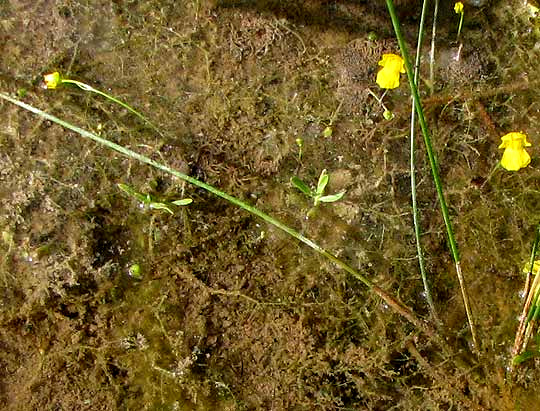
Probably this is UTRICULARIA GIBBA, sometimes called the Humped or Floating Bladderwort. It's the most widespread of all bladderwort species -- all species of the genus Utricularia -- and is found on all continents except Antarctica. It's the only species listed for Uvalde County.
Last November I felt that those plants' long spurs poking from beneath the lower flower petals disqualified them from being this species, but now I've learned that Utricularia gibba varies a great deal across the world, including having flowers with especially long spurs.
Something new is that earlier this year the genome of Utricularia gibba was sequenced. One interesting tidbit of information resulting from that exercise is that now we know that the ancestors of bladderworts split from the ancestors of tomatoes 87 million years ago...
Utricularia gibba is considered to be easily grown in home aquaria -- even small cups or bowls. In fact, I placed a small stem segment from the bladderworts found last November in a jar of water, and now that jar is thick with bladder-bearing bladderwort stems.
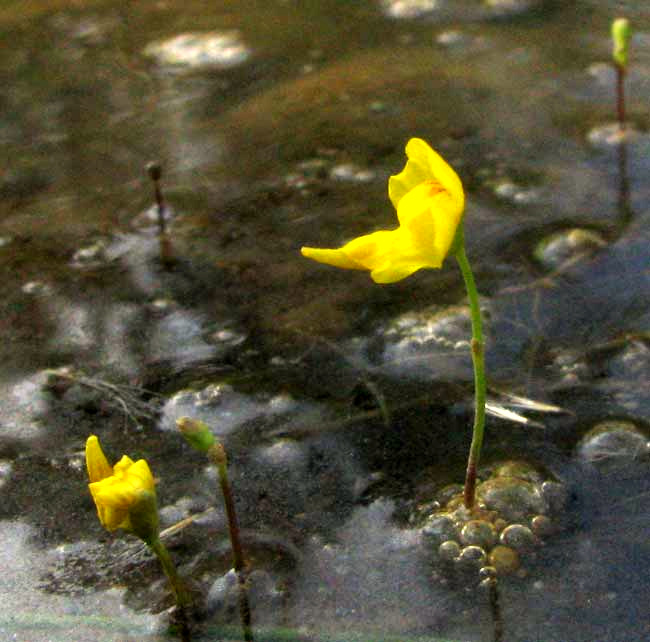
from the November 4, 2012 Newsletter issued from the valley of the Dry Frio River in northern Uvalde County, southwestern Texas, on the southern border of the Edwards Plateau; elevation ~1750m (~5750 ft); N29.62°, W99.86°; USA
BLADDERWORTS
Along the little Dry Frio River behind the cabin in a shallow, muddy pool where someone has scooped out sand and gravel with a front-end loader, several fingernail-size, yellow, snapdragon-like flowers rise about 1½ inches (4cm) from the water on slender, leafless stems, as shown above.
Most flowers bear conspicuous conical extensions, or "spurs," like some orchid flowers have, which project forward beneath the broad lower lip, as shown below:
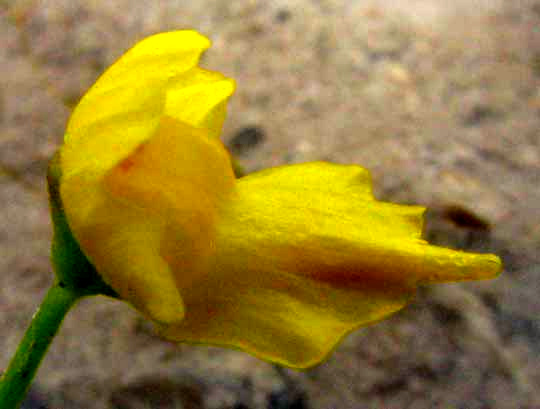
The flowers are bilaterally symmetrical, but with curiously raised, tonsil-like bulges in the throat, as shown below:

From above the population you can see that submerged in the water surrounding the flowers there's an extensive, much-branched system of leaves and stems as shown below:
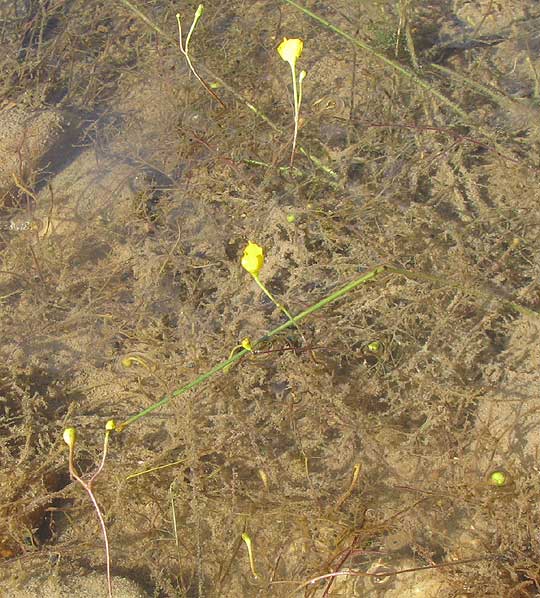
If you pick some of the submerged parts from the water you see that the strands bear large numbers of bladderlike items averaging maybe 3/16ths inch across (2mm), as shown below:

This is a wonderful, carnivorous aquatic called a bladderwort, genus Utricularia. I can't figure out which species it is, maybe UTRICULARIA GIBBA, very widely distributed though seldom common. So, this is a good find and it worries me that it's in a place where people dig gravel when they need it. I suppose the population became established there when a bird such as a sandpiper stopped at the pool and a bladderwort seed came loose from its body.
The bladderlike things in the last photo are traps for microscopic aquatic invertebrates. They aren't used for floating. They are equipped with touch-sensitive hairs, called trigger hairs, that when disturbed cause the bladders to quickly suck in water along with whatever creature set off the trap. Digestive enzymes and bacteria in the bladder then digest the prey for the nutritional use of the plant, a process typically taking 15 minutes to 2 hours, depending on how large the prey was.
from the January 19, 2014 Newsletter issued from the valley of the Dry Frio River in northern Uvalde County, southwestern Texas, on the southern border of the Edwards Plateau; elevation ~1750m (~5750 ft); N29.62°, W99.86°; USA
BLADDERWORT BLADDERS
Here in winter the bladderworts aren't flowering but sometimes you find tangles of their green, threadlike stems gathered here and there, as shown below in water half a finger deep:
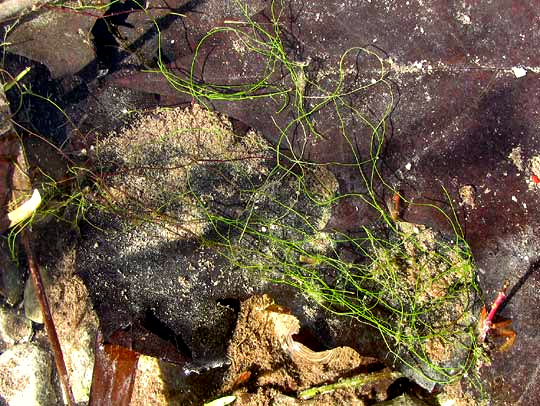
How can we be sure that this isn't just a filamentous alga? One way is to lift a thread from the water and see if it bears bladders, as shown below:

In that picture, notice the branched hairs issuing from the blackish bladder in the center. When in water and a microscopic aquatic animal brushes against one of those "trigger hairs," a kind of trapdoor suddenly opens in the bladder. Before the trapdoor opens, the bladder is not completely full of water so when it does open water bearing the prey is sucked inside and the door closes. The whole process takes only ten to fifteen thousandths of a second.
As we've seen with their yellow, snapdragon-like flowers, bladderworts are flowering plants. However, bladderworts are so highly specialized -- for one thing, their vegetative parts are not clearly separated into roots, leaves and stems -- that they have their own family, the Bladderwort Family, or Lentibulariaceae. Their bladder traps are regarded as one of the most sophisticated structures in the entire Plant Kingdom.